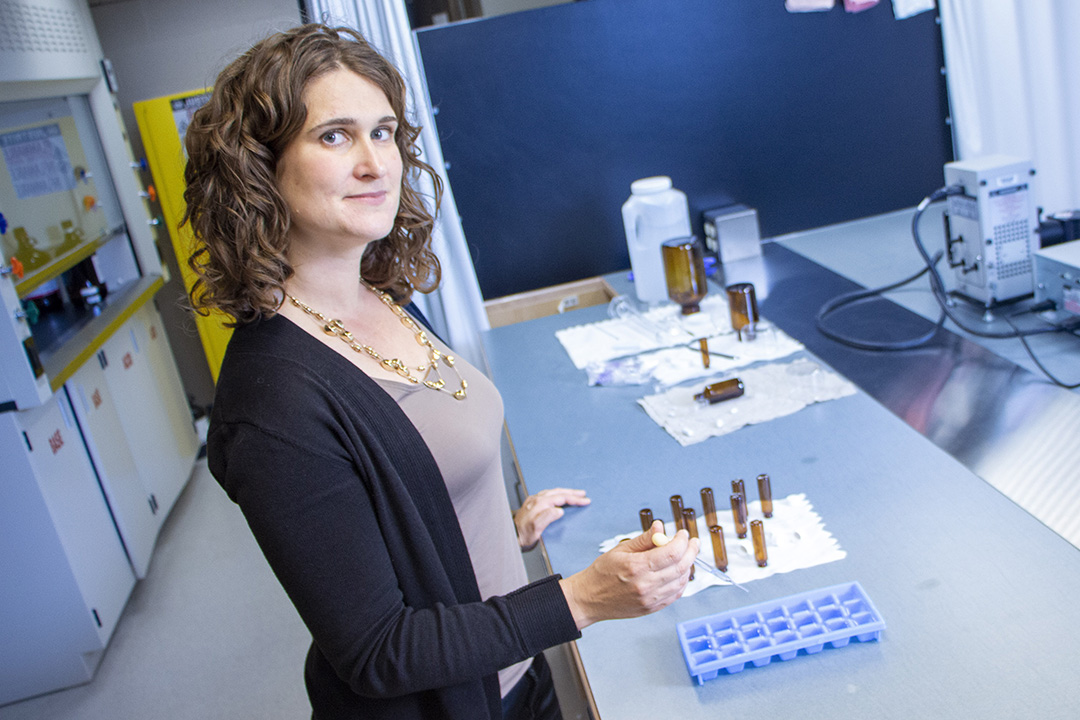
Examining environmental pollutants in ice and snow
As a longtime Saskatchewan resident, Dr. Tara Kahan (PhD) is no stranger to the cold.
By Shannon BoklaschukPerhaps it’s a natural fit, then, for the award-winning University of Saskatchewan (USask) researcher—who grew up in Regina—to be focused on environmental pollutants in snow and ice.
“Most of the world, including Saskatchewan, is covered with snow or ice for some portion of the year and chemistry just doesn’t stop,” said Kahan, a professor in the Department of Chemistry in USask’s College of Arts and Science. “It’s still happening and it’s still affecting water quality and air quality, but we don’t really know anything about it.”
Some environmental pollutants undergo different chemical reactions in frozen form than in liquid water, meaning the health effects of the pollutants may be different in the presence of snow and ice. Until the early 1990s, however, scientists didn’t really investigate the chemical transformations of pollutants in ice and snow, Kahan said.
“I guess the idea was because it was very cold that probably not much chemistry would happen, because it takes energy for reactions to occur. So, the warmer it is, the faster they will occur,” she said. “It wasn’t until scientists went to the Arctic to make what they thought were background measurements, where there would be no chemistry happening, that they realized that everything they thought they knew was wrong.”
Because of Canada’s cold weather, people living in this country also tend to spend a significant amount of time indoors. As a result, Kahan is interested in understanding the chemistry that affects air quality in our homes, vehicles and workplaces, and has developed an instrument to measure the composition of air indoors.
In June, Kahan’s work was recognized at the federal level, when she was named Canada Research Chair (CRC) in Analytical Environmental Chemistry. As a Tier 2 CRC, she will receive $120,000 per year for five years to support her research. Tier 2 CRCs are awarded to excellent emerging researchers who have been recognized by their peers as having potential to lead in their field.
Kahan jokes that she should have chosen something warmer than ice and snow to focus on.
“I had friends during my PhD who would say, ‘I’m off to Costa Rica to collect my samples,’” said Kahan, who did however have the opportunity to go to Greenland as part of her research.
“Camping on top of a glacier, it’s an experience,” she said.
Kahan laughs when asked if she always wanted to be a scientist, admitting that she actually hoped to become a gymnast as a youth. After high school she worked as a legal secretary for a couple of years before registering for university, with the goal of becoming a sociology major.
“Then I sort of fell into chemistry,” said Kahan, who also considered applied mathematics and physics as potential majors.
“I was looking through the course calendar, looking at all my prerequisites, and I thought, ‘These chemistry classes seem so interesting.’ Then I remembered yes, in fact, chemistry was one of my favourite high school classes. … So, finally everything fell into place and I did a chemistry degree.”
Kahan obtained her Bachelor of Science from the University of Regina in 2004, before moving to Ontario to complete a PhD in environmental chemistry at the University of Toronto in 2010. She was then hired as a professor at Syracuse University until 2018, when she was recruited by USask.
Kahan is enjoying working at USask and is happy to be back in her home province.
“I was just really excited when a position opened up that’s in Saskatchewan—and it was also the perfect fit for me,” she said. “I think the day the job ad came out, six different people emailed me and said, ‘Tara, this is you.’”

